Key takeaways:
- Vegan desserts utilize natural sweeteners and innovative ingredients like aquafaba and nut butter, creating rich and satisfying treats.
- Switching to vegan options offers health benefits, reduced environmental impact, and culinary versatility.
- Popular vegan desserts include creamy cheesecakes, ice creams, and cookies, showcasing how plant-based alternatives can rival traditional recipes.
- Experimentation and flexibility in substitutions are essential for achieving desired textures and flavors in vegan baking.
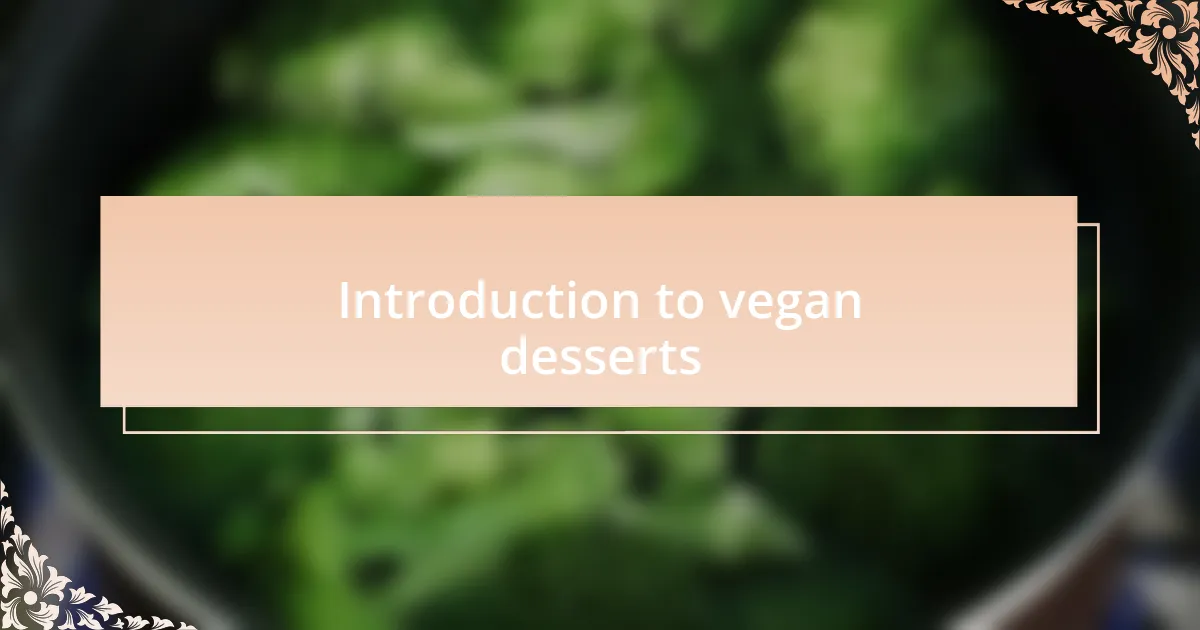
Introduction to vegan desserts
Vegan desserts have evolved tremendously in recent years, becoming a delightful surprise for anyone with a sweet tooth. I remember the first time I tried a vegan chocolate cake; it was surprisingly rich and indulgent, completely shattering my preconceived notions about plant-based treats. The beauty of these desserts lies in their ability to leverage the natural sweetness of ingredients like dates, bananas, and maple syrup, which makes them not only healthier but also incredibly satisfying.
As someone who has enjoyed a variety of desserts, I often find myself wondering about the creative substitutions that make vegan sweets possible. For instance, did you know that aquafaba, the liquid from canned chickpeas, can be whipped into a fluffy meringue? This ingenuity opens up a world of possibilities, and it’s thrilling to witness chefs experimenting with flavors and textures to create dishes that appeal to everyone, not just those following a vegan lifestyle.
Furthermore, the emotional aspect of enjoying a vegan dessert is often overlooked. There’s something uniquely satisfying about savoring a treat that aligns with one’s values, whether it’s compassion for animals, health considerations, or environmental consciousness. Personally, indulging in a vegan dessert feels like a small victory—a moment where I can treat myself while staying true to my beliefs.
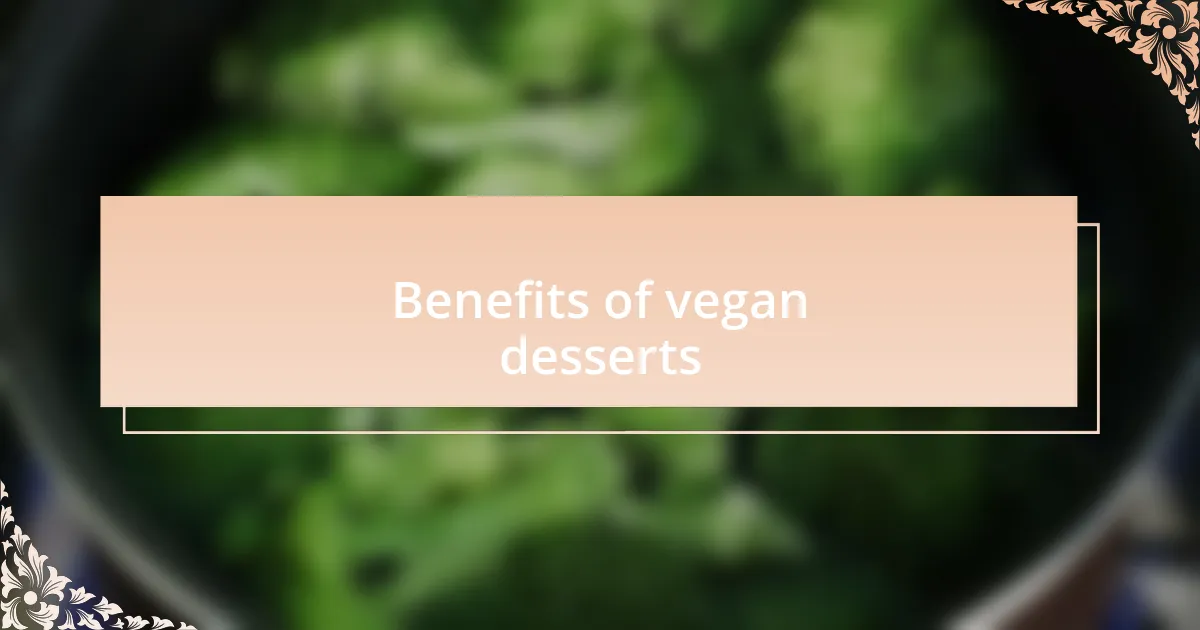
Benefits of vegan desserts
Switching to vegan desserts brings a significant health advantage. I’ve noticed that many of these treats are lower in saturated fats and cholesterol, which aligns with maintaining a balanced lifestyle. For example, when I chose a vegan brownie made with black beans instead of eggs and butter, I was amazed at how rich and fudgy it tasted while providing a protein boost.
Another benefit that stands out is the environmental impact. Embracing vegan desserts can contribute to lower resource usage, particularly when it comes to dairy and egg production. I often reflect on how my dessert choices can ripple out into larger issues, like sustainability and animal welfare. Every time I opt for a coconut cream pie instead of a traditional one, I feel like I’m making a more conscious choice that benefits the planet.
But let’s not overlook the versatility that comes with vegan desserts! From creamy cashew cheesecakes to fruit-packed sorbets, the culinary possibilities are truly endless. I remember experimenting with a recipe for vegan cookies that replaced butter with mashed avocado, resulting in a deliciously soft texture. This creativity not only enhances the flavor profiles but also makes for a fun and engaging cooking experience that everyone can enjoy.
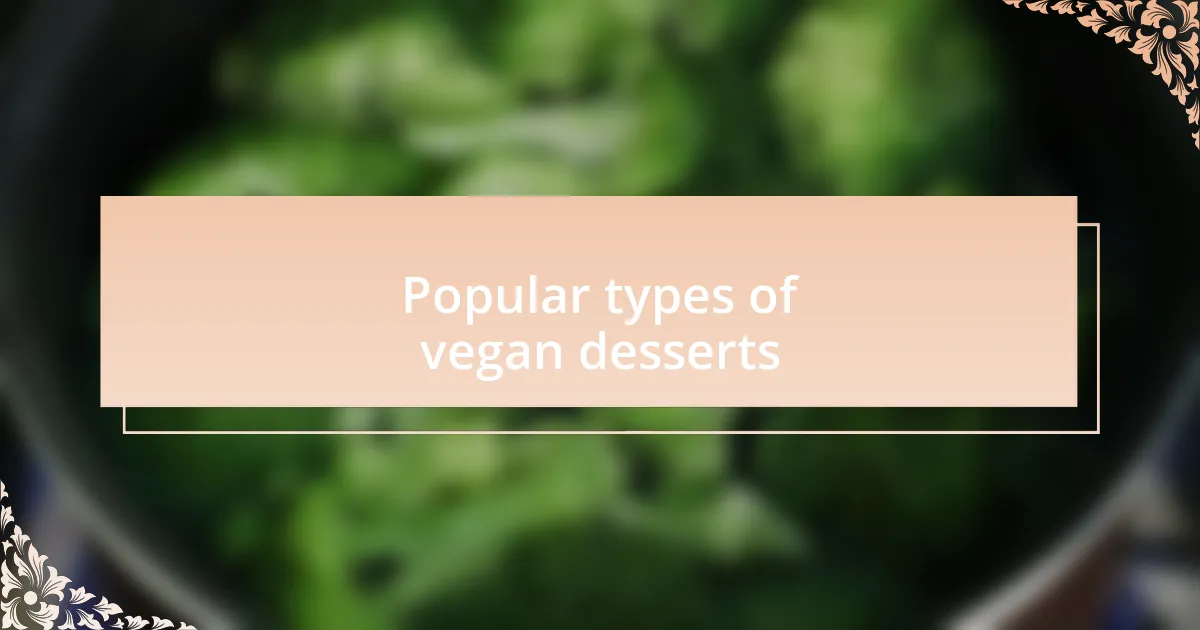
Popular types of vegan desserts
Vegan desserts come in a delightful array of options that cater to various tastes and preferences. For instance, I find myself gravitating towards dairy-free ice creams; the creamy texture derived from coconut milk or almond milk never fails to satisfy my sweet tooth. Have you ever tried a chocolate avocado mousse? It’s both indulgent and surprisingly healthy—definitely a game changer in how I view desserts.
Another favorite of mine is the vegan cheesecake, often made with cashews blended into a luscious filling. When I first tasted a slice made with a nut crust and a tangy lemon filling, it opened my eyes to how rich and satisfying vegan desserts can be. I remember sharing it with friends who were skeptical about vegan options; their expressions of surprise sparked a lively discussion about how these treats can rival traditional recipes.
Then there are the classics like vegan cookies and cupcakes, which can be magically transformed using ingredients like chia seeds or flaxseed to replace eggs. I once baked a batch of chocolate chip cookies using banana as a binding agent, and they vanished within minutes! Isn’t it fascinating how these simple substitutions can yield such delicious results? Each bite left us discussing how accessible and enjoyable vegan desserts can become, even for the staunchest of omnivores.
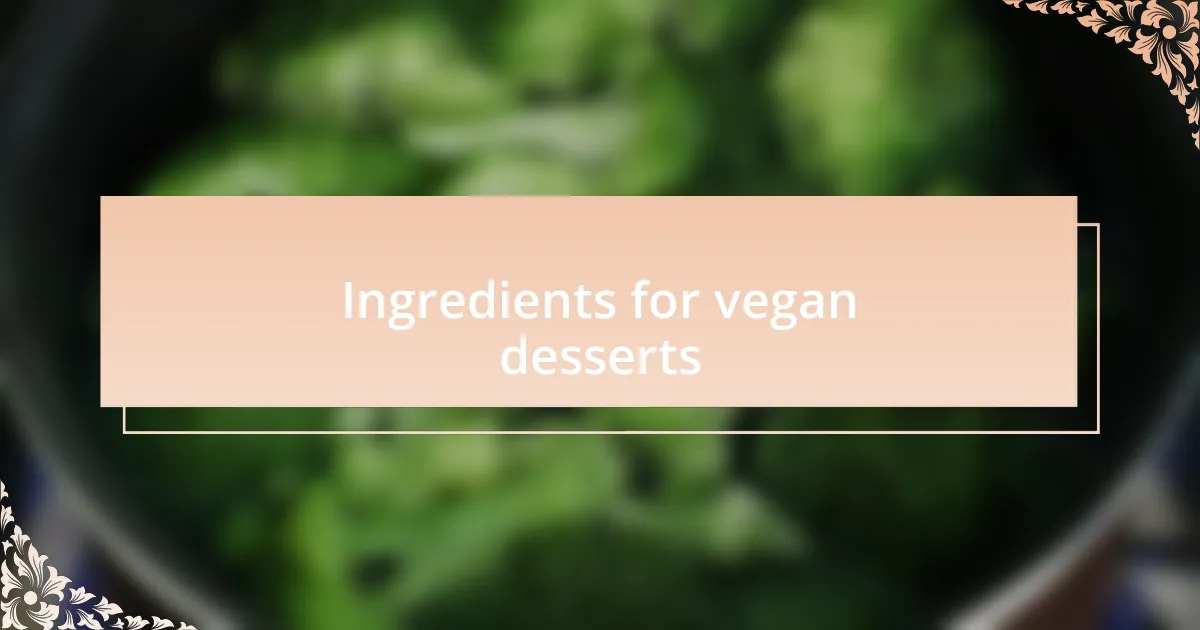
Ingredients for vegan desserts
When it comes to ingredients for vegan desserts, I must say there are some standout options that really capture the essence of traditional sweets. One of my go-to ingredients is aquafaba, the liquid from canned chickpeas. It’s incredible how this humble ingredient can whip up to form a fluffy meringue! The first time I made vegan macarons using aquafaba, I was astonished at how close they came to the real deal—such a small surprise, yet it opened my mind to the possibilities of plant-based baking.
Let’s not forget about natural sweeteners, either. I often turn to maple syrup or agave nectar instead of refined sugar. They lend a unique depth of flavor to desserts that I genuinely enjoy. I remember making a batch of brownies with maple syrup as the main sweetener; the rich caramel notes complemented the chocolate perfectly. It’s little moments like these that remind me vegan desserts can be both wholesome and delightful.
Another vital ingredient is nut butter; it adds creamy richness to vegan cookies and cakes. I once tried adding almond butter to a raw vegan brownie recipe, and it was a revelation. The result was a dense, fudgy dessert that had everyone asking for the recipe. Incorporating ingredients like this can truly elevate your baking game, don’t you think?
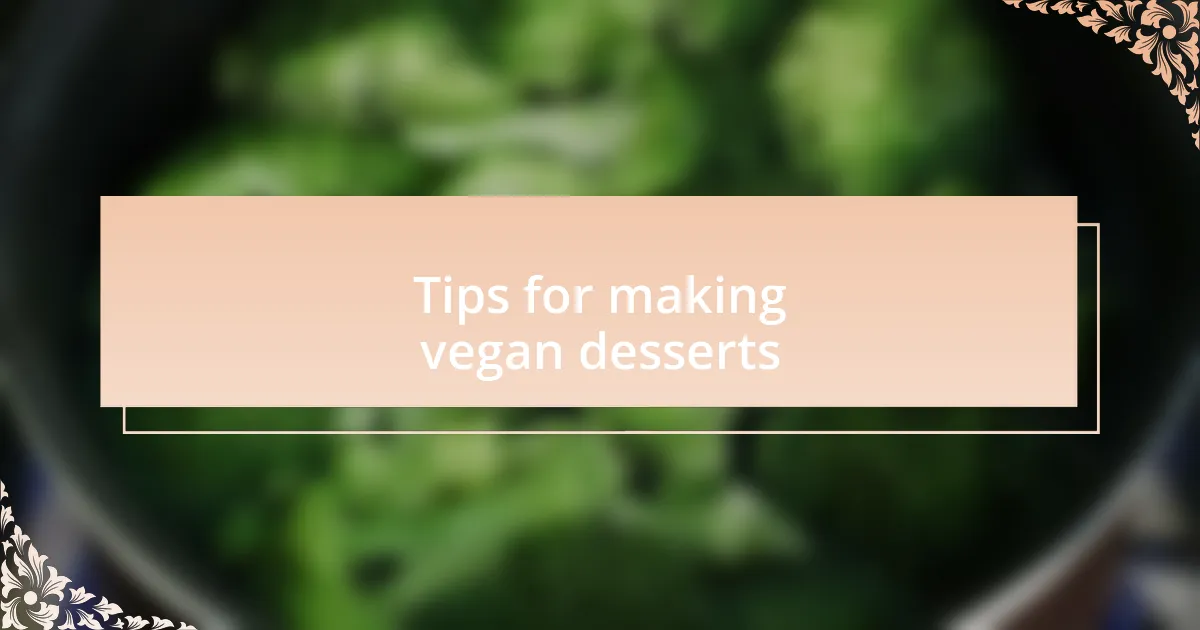
Tips for making vegan desserts
When I first started making vegan desserts, I quickly discovered the importance of texture. Using ingredients like chia seeds or ground flaxseeds can create that delightful, chewy consistency we often crave in baked goods. I remember whipping up a batch of vegan muffins and, in my excitement, added too much chia. Instead of a disaster, I ended up with a wonderfully moist treat! Who would’ve thought a little experimentation could lead to such tasty results?
Don’t overlook the power of flavoring. Natural extracts like vanilla or almond can turn a simple dessert into something truly exquisite. I recall making a basic vegan cake and adding a splash of almond extract; the aroma alone was enough to make my kitchen feel like a bakery. It’s funny how a small tweak can enhance an entire dish, don’t you agree?
Another tip I find invaluable is to embrace the art of substitutions. If you don’t have one ingredient, don’t panic! I vividly remember running out of coconut oil while baking vegan cookies. In a pinch, I used applesauce, and the cookies came out fluffy and delicious. This little incident taught me that flexibility in baking is key. Have you ever experienced a cooking mishap that turned out to be a pleasant surprise?
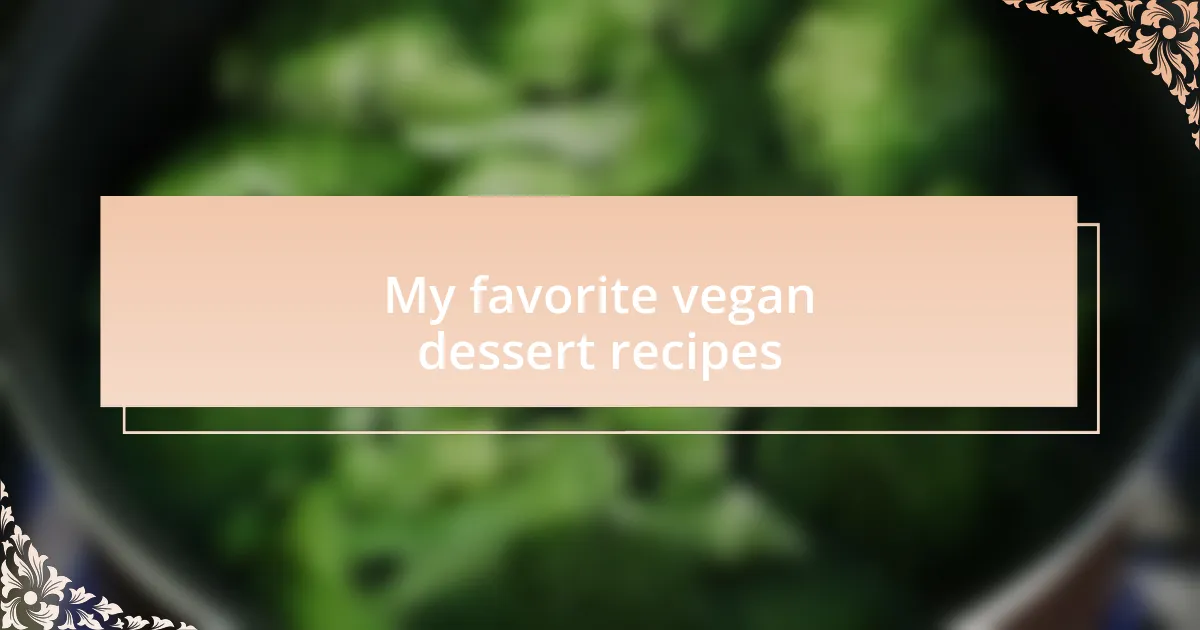
My favorite vegan dessert recipes
One of my absolute favorite vegan dessert recipes is a creamy avocado chocolate mousse. Yes, you read that right—avocado! When I first made it, I was hesitant, but blending ripe avocados with cocoa powder and a touch of maple syrup transforms a seemingly humble fruit into an indulgent treat. Each bite feels luxurious, and I often marvel at how something so simple can taste so rich. What’s your go-to ingredient for creating unexpected flavors in desserts?
Another dessert that never fails to impress is my vegan banana bread. I love how ripe bananas add natural sweetness and moisture while eliminating the need for refined sugars. I remember sharing a loaf with friends, and their faces lit up as they took their first bites. The secret? A sprinkle of cinnamon and a handful of walnuts give it that extra crunch and warmth. Have you tried incorporating any unusual spices in your baking?
Lastly, I can’t ignore the joy of no-bake vegan cheesecake. The combination of soaked cashews, coconut milk, and lemon juice creates a blissfully creamy texture that’s hard to resist. I recall making this dessert for a family gathering where everyone was skeptical at first. Watching them dive in and ask for seconds was such a satisfying moment. Who knew that something so healthy could leave such a memorable mark?